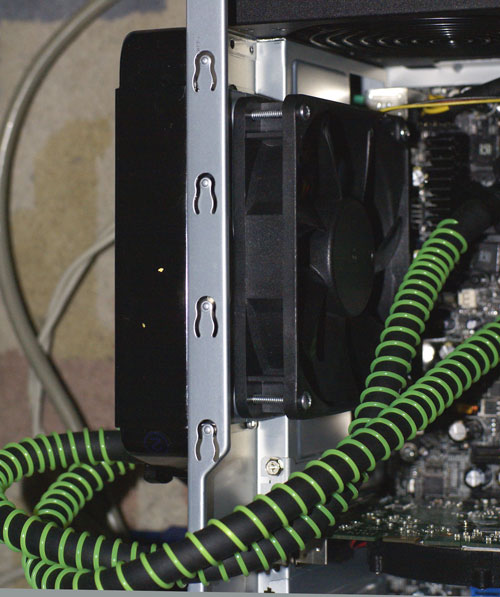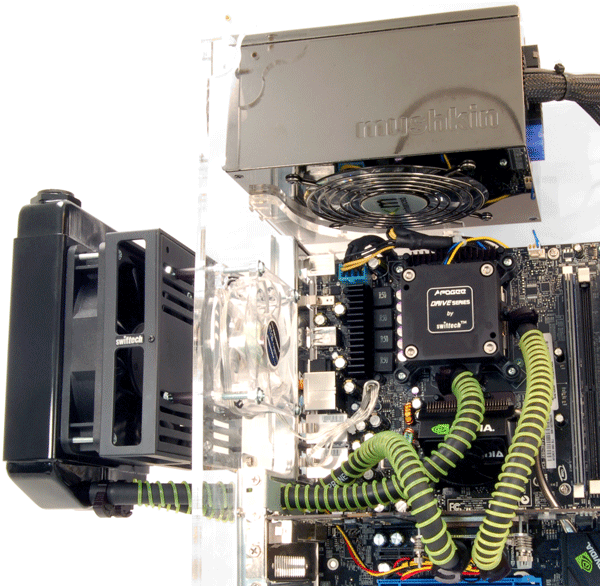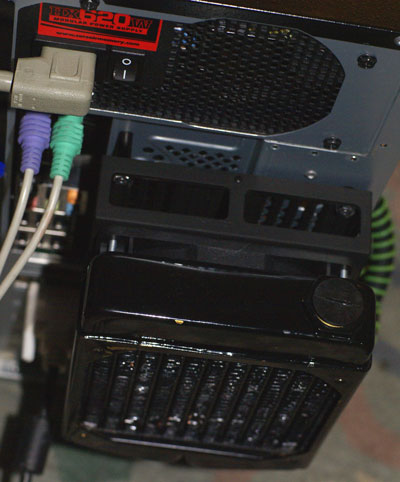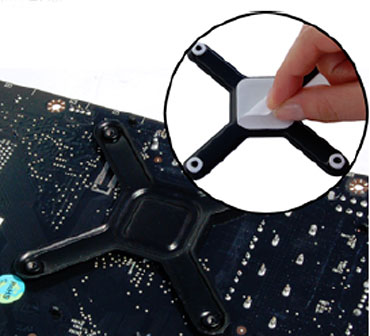Swiftech H2O-120 Compact and Corsair Nautilus 500: Is Water Better?
by Wesley Fink on September 17, 2007 6:00 AM EST- Posted in
- Cases/Cooling/PSUs
Swiftech H2O-120 Compact
Swiftech specializes in cooling for the enthusiast market. It is probably best known for its liquid cooling solutions, but Swiftech began with air cooling and has also had a few air coolers that were very well-known, like their ongoing MC and MCX air coolers for AMD and Intel. Swiftech also markets thermoelectric cooling parts, specialty ram and MOSFET coolers, and even a specially modified Antec P180 case called the QPower P180 for water cooling.
The Company was founded in 1994 by Gabriel Rouchon, incorporated in 2001, and was first publicly traded in 2005. Though there have been many changes in the company's structure over the years, it is worth mentioning that Gabe Rouchon is still very active in Swiftech, and Gabe often works directly with reviewers on tweaking the company's cooling products.
Swiftech markets both individual cooling products such as CPU water blocks, chipset and VGA water blocks, pumps, radiators, reservoirs, and cooling accessories. They also market complete water cooling kits such as the H2O-220 Apex Ultra and the H2O-80 Micro. Their newest kit, the H2O-120 Compact is the subject of this review.

The complete H2O-120 Compact kit comes packaged in a small box measuring roughly 13x7x4 inches. Everything needed for a standard Intel or AMD installation is included in the package.

The radiator/reservoir and water block/pump are well protected by the cutouts in the rigid foam block. Components are located on both the top and bottom of the Styrofoam. If you can't find the funnel it's mounted on the bottom.

You can see how much Swiftech has simplified this water cooling system by looking at the small number of parts compared to traditional water cooling kits. The fan/radiator/reservoir is basically one module, and the water block/pump is the second module. These two components are connected by pre-cut 10" Neoprene 3/8" tubes. All of the hardware for mounting is included, such as the mounting screws, Intel backplate (shipped attached to the Apogee Drive Block), a 7V electrical connector for running the fan at low speed, Arctic Silver Ceramic thermal grease, and the water additive. An alternate mounting block is also included for AMD/AM2 processor mounting.
Swiftech does not include the distilled water required for filling the system. Specialty cooling etailers and scientific equipment shops carry this; however, the most readily available source for distilled water we found is Wal-Mart, where a gallon of distilled water was less than a buck. The coolant additive is mixed with a half liter (pint or 16 oz.) of distilled water.
Installation

The kit mounts just fine in a full tower case, and it will mount fine in an Antec P180 which mounts the power supply at the bottom of the mid-tower case. The kit as supplied did fit any bottom-mount mid-tower case available for testing. However, the Swiftech H2O-120 Compact kit would not fit any top-mount power supply mid-tower case we tried. This included about six different brands of the most common top-mount PSU cases, either premium or value brands. The radiator is about a half inch too long to mount in top PSU mid-tower cases. Those equipped with 120mm exhaust fans all had screw holes that would not allow mounting of the radiator.
Both our old and new cooling test beds are top PSU mid-tower cases, and the H2O-120 Compact would not fit either case as supplied. We used that configuration because this is the case design readers most often own - it is the most common case available and accounts for the most sales. To be fair to other solutions, it was possible to find a way to install the H2O-120 Compact in the test bed case, so we could advise readers of what was needed to mount in this common design.

The easiest mount was a split design, where the radiator was mounted outside the case and the fan is inside the case. To use this mount you will need longer screws in some mid-tower cases and a longer pair of hoses. We found the 12" length worked fine in our case, and extra hoses are available from Swiftech.

When there is not enough room for the radiator, Swiftech recommends using their "Radbox" for external mounting.

You will also need longer tubing for the Radbox install, but all the necessary screws and washers come with the Radbox from Swiftech. The Radbox kit even includes a PCI slot cover for running tubing to the outside of the case for external radiator mounting.
Performance tests were run with both the split-install configuration and the recommended Radbox external configuration. Cooling results were all but identical; the recommended external install was 0C to 2C cooler at most speeds. If your 120mm grill is not perforated enough you may have to remove the fan circle for best cooling, but the kit cooled fine on our test bed with the perforated 120mm grill intact.

Once you have determined fit and decided on how you will mount the H2O-120 Compact you will need to assemble and leak test the water cooling system. The Intel 775 block requires a back plate so you will have to remove the motherboard to install the water cooling system. It was easiest for us to stick or tape the back plate to the motherboard and remount it for final install, because we strongly advise testing for leaks before mounting the system over the motherboard.

In a standard install everything is inside so you can attach the tubes, fill the system and operate the pump away from the computer. The manual includes information on how to run the power supply to test the system, before it is installed on the motherboard.

On the installs with the radiator outside the case you will have to plan assembly and water testing, since the water system should be filled after the tubes are passed through the PCI slot. The tubes for external mount were long enough that the Apogee block could dangle from inside the case to the outside for filling and leak testing. The apogee block was dangled over the back on a dry cloth for leak-testing where the tubing needed to pass though the PCI bracket.
The bottom line on installation is that the standard install is relatively simple, and it is definitely much simpler than the traditional four component water cooling systems. If you are a first-time water cooling installer and the system fits your case, 30 minutes is probably a reasonable time to install. However, if you are installing in a top PSU mid-tower case you will need to buy or order parts, carefully plan your install, and it will take an hour or more to install the system once your parts arrive. The penalty for a sloppy install without leak testing could be a dead motherboard and CPU, so we strongly recommend that you take your time and use the precautions necessary to assure you have a leak-proof water system.
Swiftech specializes in cooling for the enthusiast market. It is probably best known for its liquid cooling solutions, but Swiftech began with air cooling and has also had a few air coolers that were very well-known, like their ongoing MC and MCX air coolers for AMD and Intel. Swiftech also markets thermoelectric cooling parts, specialty ram and MOSFET coolers, and even a specially modified Antec P180 case called the QPower P180 for water cooling.
The Company was founded in 1994 by Gabriel Rouchon, incorporated in 2001, and was first publicly traded in 2005. Though there have been many changes in the company's structure over the years, it is worth mentioning that Gabe Rouchon is still very active in Swiftech, and Gabe often works directly with reviewers on tweaking the company's cooling products.
Swiftech markets both individual cooling products such as CPU water blocks, chipset and VGA water blocks, pumps, radiators, reservoirs, and cooling accessories. They also market complete water cooling kits such as the H2O-220 Apex Ultra and the H2O-80 Micro. Their newest kit, the H2O-120 Compact is the subject of this review.

The complete H2O-120 Compact kit comes packaged in a small box measuring roughly 13x7x4 inches. Everything needed for a standard Intel or AMD installation is included in the package.

The radiator/reservoir and water block/pump are well protected by the cutouts in the rigid foam block. Components are located on both the top and bottom of the Styrofoam. If you can't find the funnel it's mounted on the bottom.

You can see how much Swiftech has simplified this water cooling system by looking at the small number of parts compared to traditional water cooling kits. The fan/radiator/reservoir is basically one module, and the water block/pump is the second module. These two components are connected by pre-cut 10" Neoprene 3/8" tubes. All of the hardware for mounting is included, such as the mounting screws, Intel backplate (shipped attached to the Apogee Drive Block), a 7V electrical connector for running the fan at low speed, Arctic Silver Ceramic thermal grease, and the water additive. An alternate mounting block is also included for AMD/AM2 processor mounting.
Swiftech does not include the distilled water required for filling the system. Specialty cooling etailers and scientific equipment shops carry this; however, the most readily available source for distilled water we found is Wal-Mart, where a gallon of distilled water was less than a buck. The coolant additive is mixed with a half liter (pint or 16 oz.) of distilled water.
Installation

The kit mounts just fine in a full tower case, and it will mount fine in an Antec P180 which mounts the power supply at the bottom of the mid-tower case. The kit as supplied did fit any bottom-mount mid-tower case available for testing. However, the Swiftech H2O-120 Compact kit would not fit any top-mount power supply mid-tower case we tried. This included about six different brands of the most common top-mount PSU cases, either premium or value brands. The radiator is about a half inch too long to mount in top PSU mid-tower cases. Those equipped with 120mm exhaust fans all had screw holes that would not allow mounting of the radiator.
Both our old and new cooling test beds are top PSU mid-tower cases, and the H2O-120 Compact would not fit either case as supplied. We used that configuration because this is the case design readers most often own - it is the most common case available and accounts for the most sales. To be fair to other solutions, it was possible to find a way to install the H2O-120 Compact in the test bed case, so we could advise readers of what was needed to mount in this common design.

The easiest mount was a split design, where the radiator was mounted outside the case and the fan is inside the case. To use this mount you will need longer screws in some mid-tower cases and a longer pair of hoses. We found the 12" length worked fine in our case, and extra hoses are available from Swiftech.

When there is not enough room for the radiator, Swiftech recommends using their "Radbox" for external mounting.

You will also need longer tubing for the Radbox install, but all the necessary screws and washers come with the Radbox from Swiftech. The Radbox kit even includes a PCI slot cover for running tubing to the outside of the case for external radiator mounting.
Performance tests were run with both the split-install configuration and the recommended Radbox external configuration. Cooling results were all but identical; the recommended external install was 0C to 2C cooler at most speeds. If your 120mm grill is not perforated enough you may have to remove the fan circle for best cooling, but the kit cooled fine on our test bed with the perforated 120mm grill intact.

Once you have determined fit and decided on how you will mount the H2O-120 Compact you will need to assemble and leak test the water cooling system. The Intel 775 block requires a back plate so you will have to remove the motherboard to install the water cooling system. It was easiest for us to stick or tape the back plate to the motherboard and remount it for final install, because we strongly advise testing for leaks before mounting the system over the motherboard.

In a standard install everything is inside so you can attach the tubes, fill the system and operate the pump away from the computer. The manual includes information on how to run the power supply to test the system, before it is installed on the motherboard.

On the installs with the radiator outside the case you will have to plan assembly and water testing, since the water system should be filled after the tubes are passed through the PCI slot. The tubes for external mount were long enough that the Apogee block could dangle from inside the case to the outside for filling and leak testing. The apogee block was dangled over the back on a dry cloth for leak-testing where the tubing needed to pass though the PCI bracket.
The bottom line on installation is that the standard install is relatively simple, and it is definitely much simpler than the traditional four component water cooling systems. If you are a first-time water cooling installer and the system fits your case, 30 minutes is probably a reasonable time to install. However, if you are installing in a top PSU mid-tower case you will need to buy or order parts, carefully plan your install, and it will take an hour or more to install the system once your parts arrive. The penalty for a sloppy install without leak testing could be a dead motherboard and CPU, so we strongly recommend that you take your time and use the precautions necessary to assure you have a leak-proof water system.










58 Comments
View All Comments
MercenaryForHire - Tuesday, September 18, 2007 - link
Folks, this is a review of off-the-shelf watercooling components. Not a customized, modded, build-it-yourself Hoover Dam setup. And the conclusions drawn I think are valid - if you want good results from watercooling, be prepared to fork over some significant coin, or source the parts yourselves and DIY.jebo - Tuesday, September 18, 2007 - link
Exactly. I find it interesting how all the water coolers are crying that AT said "Air is better than water". Well, the fact remains, that if you compare a $70 air cooler to a $150 water cooler, air is > water. You need to spend $300+ to get a h2o system that is better than a $70 air cooler. At that point, the cost concerns become prohibitive.psychotix11 - Tuesday, September 18, 2007 - link
Part of the problem with this review is that it's managed to convince novice users that it does require 300+, which is either a distortion of truth to make a point, or ignorance about basic water cooling.Pump - 65, apogee GT - 45, double rad - 50, misc crap (tubing, fittings, fans) - 20.
For exactly around 200 bucks you can construct a loop that will demolish any air cooling on the market. You could even toss another radiator into the swiftech kit and keep it under 200.
For 300 bucks you could toss in a 3x120mm rad, upgrade the CPU block, and liquid cool the NB and go even farther.
For a 300+ configuration the sky is the limit.
Also I've noticed the numbers they get don't match what other reviews have put out for a lot of the items used.
Nickel020 - Tuesday, September 18, 2007 - link
As aigormola stated, ~200$ watercooling setups will beat any air cooling. A dual radiator doubles the heat dissipation capacity and is like 10$ more than a single.And don't forget that you can keep you watercooling setup for like 5 years, while you usually get one 50-80$ heatsink and fan every time you upgrade your PC.
The review is fine, but the conclusion is the worst one I've seen in 5 years of reading reviews at AT. It's just plain wrong and will mislead a lot of people.
aigomorla - Monday, September 17, 2007 - link
First off, your picking the subject area which holds the most debate. Its a common ground fact that a 120x1 radiator will be lacking. Your test subjects were in fact both 120x1 radiators. One was made of ALU and the other Copper.Your looking at entry lvl water cooling and using it as a comparison of middle class custom setups.
If you look at the swiftech APEX 220 series, you'll see your statement at the end not hold true.
The direct drive released by swiftech on a 120x1 platform, as well as the corsair nautilus is not the best grounds to claim such statements. The reason is the lack of the radiator.
120x2 radiator setups such as the swiftech Apex220 setup will eat the two coolers you listed and also any air setup you could possible throw. This unit is also modestly a bit over 200 dollars. Last price checked at jab-tech showed it to be 209 dollars for the complete setup.
Also your making a lot of potential people who are interested in h2o migration think twice. Your passing more myths on watercooling then i can think of. If you feel i am wrong in any statement, i recomend you contact Gabe, owner of swiftech and tell him you would like to give the company a chance to prove how powerful h2o cooling can be by giving you a sample of there APEX 220 system. Im sure Gabe will be all over it.
Also, you need to retract your statement about the 300 dollar mark. 200-300 is considered mid tier water cooling and no air can match to that calibur.
@ the guy who was about to migrate to the MCR320. Go ahead, and dont look back. This review only proved the power of 120x1 radiator. Its very lacking, however the moment you step up to a beefier radiator, 120x2 or 120x3 in your case, you'll see all the air people left behind in your rear view mirror. 2x the cooling power for the 220, and 3x the cooling for the 320.
Lets not even get into the power of a thermochill PA120.3 Believe me, its a very very big margin once you get there.
I am the creator of the watercooling thread sticky over at anandtech forums, and i was VERY disappointed in this article. The members over at Xtremesystems think this is a joke. These are the guys who are the front run pioneers in h2o cooling.
I ask polietly that you remove that comment of the 300 dollar being topped by high end air until you've tested an APEX 220 unit. All you have done was test 2 low end units in h2o and based a final conclusion.
walltari - Tuesday, September 18, 2007 - link
Very interesting review a pretty tough discussion but everybody forget one thing. You look only on very expensive kits useally common in U.S. or western Europe. I live in Czech republic (Eastern Europe) and I see another choises. I have completly watercooled PC. Radiator 2x120, pump with expansion and filling tank, CPU blok, GPU blok, Chipset blok, 2x HDD blok a this kit i bought for 210$. In this price you coudn´t buy ale these aircoolers and have same results. (I bought it form company www.viscool.com). I hear, and that´s the problem, that everybody have, DVD-rom.In the review author hit the problem of the noise. Really the pump is the most noisest thing. I´m interested in building watercooled systems for three years and at first it is neceseary eliminate vibrations. The differnce is that my system and systems of this firm is waterpump included in watertank. This solutions lower noise to minimum level. They have 2 watertanks, one, included in kit, is smaller and second, which they made especially for me, because o my larger and more powerfull pump.
PS: Sorry for my english, I´m beginer
rotNdude - Monday, September 17, 2007 - link
Which direction was the fan blowing on the Swiftech kit? Since you mounted the rad off the back of the case and the fan appeared to be in the case, was it exhausting air or pulling ambient air?Also, how much fluid was actually added to each cooling loop?
Wesley Fink - Monday, September 17, 2007 - link
We used the existing case fan IN the case exhausting air. We also used the fan that came in the H2O-120 kit blowing air in the same direction. There is a 1-1/2" to 2" space created by the Radbox so air was being drawn in form the sides of the rad box.The pre-cut tubing in the Swiftech kit is about 10" long each. We used 12" tubes to reach the external RadBox mounted Readiator/Reservoir.
Jodiuh - Monday, September 17, 2007 - link
Thank you guys very much for using this universally accepted tool. I've always wondered why the temps for Thermalright's Ultra 120 Extreme were better than what I could achieve. There's 4 factors here:-ambient (20C-22C vs 24C-26C)
-temp monitor (NV vs core temp)
-fan (1600RPM vs 1200RPM)
-load app (farcry vs orthos blend) <--this might not matter
I'm currently loading an E6400@3500 between 62C-66C w/ 1.475 in bios (1.43 actual) when running orthos blend.
Thanks again! Maybe orthos blend could be used in future or even ran again on past coolers?
rochlin - Monday, September 17, 2007 - link
These results totally make sense if the laws of physics have anything to do with it.There are some advantages to water cooling vs air, but you have to take advantage of them:
Heat dissipation and the high specific heat of water: Because the dissipation of heat is separated from the CPU, you can have a bigger and more efficient heat sink than you can ever fit on top of a cpu.
Also, because the heat dissipation (heat sink) is outside of the case, you can use the presumably cooler air outside the case to cool the heatsink.
The point is, the water needs to be cooled. If the heat sink/fan setup cooling the water is no better than what you attach to your cpu, then the system will NOT cool your cpu any better. You will be recirculating relatively warm water back to the cpu.
A sensible approach would be to build a giant heat sink. It could be aluminum (cheap) and big enough so the WHOLE case could sit on top of it. A channel for the water would zig zag under it. This kind of heat exchanger (like used in solar water systems) would cool the water much much more than anything you could fit inside the case.
The relatively small heat exchangers in the two tested units just aren't going to outperform the terrific Themalright 120 Extreme heatexchanger unless your air temps inside the case get out of hand. The advantage of the heat transfer capability of water is WASTED unless you cool it down with a better heat exchanger outside the case.